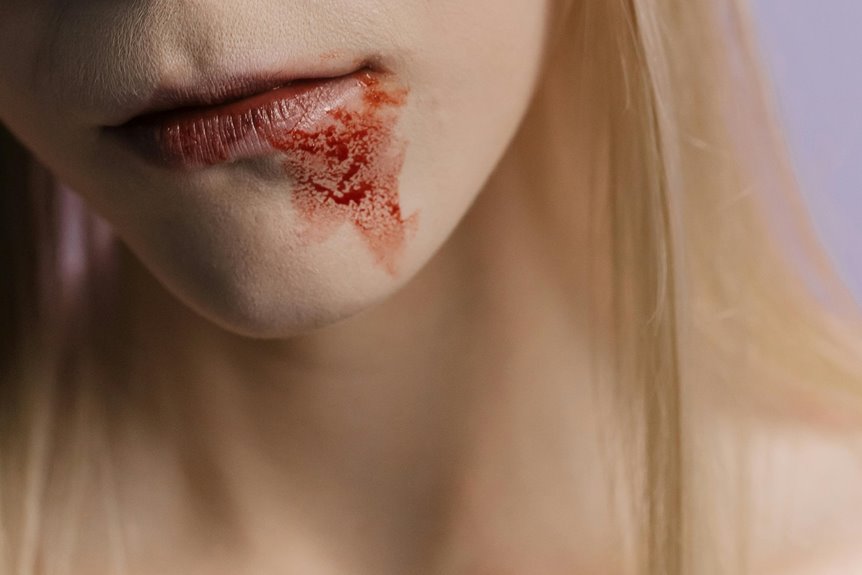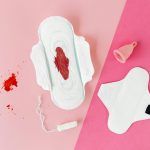To remove fresh blood stains from upholstery, immediately blot with a clean cloth using cold water to avoid setting the stain, then gently apply a mild detergent solution. For dried stains, test and use an enzyme-based cleaner or 3% hydrogen peroxide carefully on a hidden spot first. Always avoid scrubbing to prevent fabric damage, and dry thoroughly to prevent mildew. If you want to handle stains safely and preserve your upholstery, there’s more you can do to get the best results.
Table of Contents
Key Takeaways
- Blot fresh blood stains gently with a dry cloth and cold water to avoid pushing blood deeper into the upholstery fabric.
- Apply a mild detergent mixed with cold water to blot the stain, testing first for colorfastness on a hidden area.
- Use 3% hydrogen peroxide cautiously on fresh stains after spot-testing, allowing bubbling before blotting and drying thoroughly.
- For dried blood stains, apply an enzyme-based cleaner, let it sit 10-15 minutes, then blot gently without scrubbing.
- Dry the cleaned area completely with airflow and seek professional cleaning for large, delicate, or stubborn blood stains.
Understanding Different Types of Upholstery Fabrics
Before you tackle blood stains, you need to know what kind of upholstery fabric you’re dealing with. Different fabrics react differently to cleaning methods and solutions, so identifying the material is essential.
Natural fibers like cotton and linen absorb stains quickly but are generally easier to clean. Synthetic fabrics such as polyester and nylon resist stains better but can be sensitive to harsh chemicals.
Delicate fabrics like silk or velvet require gentle treatment to avoid damage. Check the manufacturer’s label or test a small hidden area first to see how the fabric reacts to water or cleaning agents.
Knowing your fabric type helps you choose the right stain removal approach, preventing further damage and increasing the chances of completely removing the blood stain from your upholstery.
Immediate Steps to Take for Fresh Blood Stains
When blood spills on your upholstery, act quickly to prevent the stain from setting. First, blot the area gently with a clean, dry cloth or paper towel to absorb as much blood as possible. Avoid rubbing—that only pushes the blood deeper into the fabric.
Next, use cold water to dampen a cloth, then continue blotting to lift more blood out. Make sure not to oversaturate the fabric, as excess moisture can cause damage or spread the stain.
If you have access to a stain remover designed for upholstery, apply it according to the instructions, but only after blotting. Throughout this process, be gentle to protect your upholstery’s fibers.
Prompt action makes a significant difference in successfully removing fresh blood stains.
Using Cold Water and Mild Detergent Effectively
You’ll want to pick a mild detergent that’s gentle on your upholstery but tough on stains.
Always use cold water to avoid setting the blood stain deeper into the fabric.
Applying it carefully helps break down the stain without damaging the material.
Choosing Appropriate Detergents
Although it might be tempting to reach for strong cleaners, using cold water and a mild detergent is the best way to protect your upholstery while tackling blood stains.
When choosing a detergent, look for one labeled “gentle” or “for delicate fabrics.” Avoid bleach or enzymes, as they can damage fibers or set the stain. A mild dish soap or laundry detergent with minimal additives works well.
Be certain the detergent is fragrance-free and dye-free to prevent discoloration. Always test a small, hidden area first to check for colorfastness.
Using the right detergent guarantees you break down the blood without harming your upholstery, making stain removal effective and safe. Stick to these guidelines to keep your furniture looking clean and fresh.
Applying Cold Water Correctly
Selecting the right detergent sets the stage for how you apply cold water to treat blood stains.
Begin by mixing a small amount of mild detergent with cold water—never use hot water, as it can set the stain. Dampen a clean cloth with this solution, then gently blot the stained area.
Avoid rubbing, which can push the blood deeper into fibers. Work from the outside of the stain toward the center to prevent spreading.
After blotting, use a separate cloth dampened with plain cold water to rinse the detergent out. Pat the area dry with a towel and let it air dry completely.
Repeat if necessary, but be patient; cold water and mild detergent work best when applied carefully and consistently.
Applying Hydrogen Peroxide on Blood Stains
When using hydrogen peroxide on blood stains, make sure you choose a 3% concentration to avoid damaging your upholstery.
Test a small hidden area first to check for colorfastness.
Apply it gently with a cloth or cotton swab, letting it bubble before blotting it away carefully.
Choosing the Right Concentration
Since hydrogen peroxide comes in various concentrations, you’ll want to pick the right one to effectively remove blood stains without damaging your upholstery.
Using too strong a solution can bleach or weaken the fabric, while too weak mightn’t lift the stain. Typically, a 3% concentration is safe and effective for most upholstery types.
Keep these points in mind when choosing your hydrogen peroxide concentration:
- 3% solution: Ideal for fresh or light stains; safe for most fabrics.
- Higher concentrations (6% or above): Use cautiously; test on a hidden area first.
- Dilution: You can dilute stronger peroxide with water to reduce strength and risk.
Choosing wisely guarantees you tackle the stain efficiently while preserving your upholstery’s appearance.
Safe Application Techniques
Although hydrogen peroxide is effective for removing blood stains, you’ll want to apply it carefully to avoid damaging your upholstery.
Start by testing a small, hidden area to check for colorfastness. Use a 3% solution and apply it sparingly with a cotton swab or clean cloth.
Dab the stain gently—don’t rub, as this can spread the blood and harm the fabric. Let the peroxide bubble and sit for a few minutes to break down the stain.
Then, blot it with a clean cloth to lift the residue. Avoid saturating the fabric; too much liquid can cause water stains or weaken fibers.
Always dry the area thoroughly afterward, using a fan or open window to prevent mold or mildew growth.
Removing Dried Blood With Enzyme-Based Cleaners
If you’ve dealt with dried blood stains on your upholstery, enzyme-based cleaners offer an effective solution. These cleaners break down the proteins in the blood, making it easier to lift stubborn stains.
When using them, follow these steps for best results:
- Test the cleaner on a hidden area first to avoid discoloration.
- Apply the enzyme cleaner generously to the dried stain and let it sit for 10-15 minutes.
- Blot the area gently with a clean cloth, avoiding rubbing to prevent spreading.
Make sure to follow the product instructions closely, as some may require rinsing or additional treatment.
Enzyme-based cleaners are especially useful for organic stains like blood, giving you a reliable method to restore your upholstery without harsh chemicals.
Homemade Solutions for Blood Stain Removal
Home remedies can be a convenient and cost-effective way to tackle blood stains on your upholstery.
You can start with cold water and salt: mix a tablespoon of salt in two cups of cold water, then gently dab the stain with a clean cloth soaked in the solution.
Another effective option is hydrogen peroxide, especially for fresh stains; apply a small amount directly onto the stain and blot carefully.
Baking soda paste also works—mix baking soda with water to form a paste, apply it to the stain, let it sit for 30 minutes, then wipe away with a damp cloth.
Always test these solutions on a hidden area first to avoid damage.
These simple homemade methods can help you lift blood stains without harsh chemicals.
Techniques for Blotting and Avoiding Stain Spread
Mastering three key blotting techniques can make a huge difference when removing blood stains from upholstery.
Mastering key blotting techniques significantly improves removing blood stains from upholstery without damage or spreading.
When you deal with blood stains, avoid rubbing as it spreads the stain and pushes it deeper into the fabric. Instead, focus on blotting gently but effectively.
Here’s how you can do it:
- Use a clean, white cloth or paper towel to prevent color transfer.
- Dab the stain from the outside edge inward to contain it and avoid spreading.
- Apply light pressure repeatedly, lifting the stain rather than pushing it around.
Preventing Damage to Upholstery During Cleaning
While removing blood stains, you’ll want to take care not to damage your upholstery’s fabric or finish. Always test any cleaning solution on a hidden spot first to check for colorfastness or fabric reaction.
Use gentle blotting motions instead of scrubbing to avoid fraying fibers or spreading the stain. Avoid harsh chemicals like bleach unless the fabric specifically allows it. Stick to mild detergents or specialized upholstery cleaners.
Don’t saturate the fabric; excess moisture can weaken adhesives or cause mold. Use a soft cloth or sponge to apply cleaners and rinse with minimal water.
Finally, dry the area thoroughly with a fan or open window to prevent mildew. Taking these precautions will help you remove blood stains effectively without harming your upholstery.
When to Seek Professional Upholstery Cleaning Services
Even with careful cleaning, some blood stains may prove stubborn or risk damaging your upholstery if you try to remove them yourself.
You should consider professional cleaning when:
- The stain covers a large area or has deeply set into the fabric.
- Your upholstery is made of delicate or antique materials that require special care.
- Previous attempts to clean the stain have made it worse or left discoloration.
Professionals have the right tools and expertise to tackle tough stains safely, preserving your furniture’s appearance.
Don’t hesitate to call in experts if you’re unsure about the best approach or want to avoid costly damage.
Investing in professional services can save you time and protect your upholstery’s lifespan.
Frequently Asked Questions
Can Blood Stains Cause Odor if Not Cleaned Promptly?
You might not notice it right away, but if you don’t clean blood stains quickly, they can start to smell. The odor comes from bacteria breaking down the blood, so acting fast is key to avoiding that unpleasant scent.
Are There Specific Upholstery Fabrics That Resist Blood Stains Better?
You’ll find that synthetic fabrics like polyester and nylon resist blood stains better than natural fibers. These materials repel liquids more effectively, making stains less likely to set in and easier for you to clean up promptly.
How Long Does It Take for Blood Stains to Set Permanently?
Picture blood drying slowly, sinking into fabric fibers. You’ll find it starts setting within minutes, but after 24 hours, those stains become stubbornly permanent, making quick action essential before they embed deeply and resist removal.
Can Pet Hair Impact the Effectiveness of Blood Stain Removal?
Pet hair can definitely impact stain removal since it traps dirt and blood, making cleaning tougher. You’ll want to vacuum thoroughly before treating the stain to improve your chances of completely removing the blood from your upholstery.
Is It Safe to Use Steam Cleaners on Blood-Stained Upholstery?
Steam cleaners swiftly sanitize, but you shouldn’t use them on blood-stained upholstery since steam sets stains, making them stubborn. Instead, spot-treat stains first, then consider steam cleaning for overall upholstery freshness afterward.
- Recycling Nonwoven Fabrics: Is It Possible? - July 11, 2025
- Recycling Nonwoven Fabrics: Is It Possible? - July 11, 2025
- Recycling Nonwoven Fabrics: Is It Possible? - July 11, 2025






